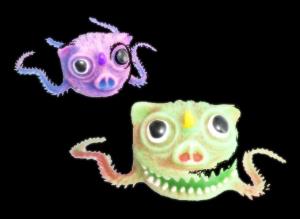
“Mommy, I did have a bad dream,” said my small son after he had once again climbed into our bed in the middle of the night and we all did the midnight game of “shuffle-mattress”.
Why do phobias suddenly appear?
I have no idea where this crocodile comes from, but he is becoming quite a regular night-time visitor. As far as I know, my little boy’s only contact with crocodiles has been via a children’s book featuring a very cute cartoon croc some months back – to my mind, not scary at all. But his little mind is growing and developing and in the process, opening up in interesting and not always understandable ways.
Johannesburg-based educational psychologist Mandy Laskey says, “There are a number of reasons why fears emerge. Some are around a child’s fears for his own safety, for example the physical fear of being dropped – or separation anxiety, which usually begins at around 8 months and lasts till around 18 months. Separation anxiety often peaks at around 15 months and then starts to decline, and in its place can come new phobias and fears.
“Cognitive development in toddlers plays an important role in the development of fears. Children of about 2 to 3 years old become more aware of their environment, and as a result may become more aware of the possible dangers.
“The increase in a toddler’s capacity for abstract thinking, and the development of his imagination, especially between the ages of 3 and 4, also results in an increased capacity to imagine both friendly and scary scenarios. At this age, the boundaries between the real and the imaginary are often blurred, and as a result it’s often difficult for toddlers to tell the difference between what’s real and what’s not.”
A normal stage of development
Burgie Ireland, Johannesburg-based parenting educator and registered midwife, comments: “This means that the development of fears in your child is a normal stage of development. As your child explores the world around him, he also discovers that things can go wrong and that his world isn’t always predictable.”
As your child’s thought processes becomes more complex, he can create frightening scenarios out of everyday objects, such as the vacuum cleaner that sucks things up, or the drain in the bath down which water disappears. He may wonder whether the vacuum cleaner or drain could make him disappear too.
Burgie adds, “He can also create entirely imaginary threats, perhaps from story books or TV programmes and movies, which can culminate in that monster under the bed or the crocodile in the dream. As your child becomes more tuned in to his surroundings, he starts reacting to stresses he wasn’t aware of a few months ago.”
Emotional factors
As children develop, they become aware of their emotions and can become anxious for many reasons. Your child may develop a new fear of insects, which might be based on your own fears of “creepy-crawlies”. If a dog growled at him he may suddenly become afraid of the dog.
In addition, as Mandy explains, toddlers begin to become more aware of their feelings and those of others. This becomes frightening for them, particularly when it involves negative emotions such as anger and jealousy. They realise that if they can get angry, others can too. This could contribute towards fears that they may be punished for having aggressive wishes, such as wanting to hurt a new sibling.
Mandy says, “As a child begins to identify negative emotions, he may be taught not to express them. This may send the message that these emotions aren’t okay, and as he has no outlet for such feelings, they may be projected in some form or another into the outside world. This can ultimately lead to his imagining the presence of monsters and other scary creatures.”
Environmental factors
Burgie says, “Monsters can also come from a scary movie or story when your child replays parts of it in his vivid imagination. A traumatic event can also leave your toddler feeling uncomfortable with emotions that he’s not quite certain how to deal with and so fears may arise. This could range from the arrival of a new sibling to his parents fighting in front of him. It could include a fall, a car accident or being witness to a violent crime.”
Parental anxiety
If a parent or other caregiver is very anxious, their fear may be transmitted to your toddler. For example, a mother who is afraid of drowning may warn their toddler repeatedly to be careful around water, with the result that the child may become overly fearful of water.
Tips for dealing with toddler fears
Acknowledge your child’s fear
Some of his fears, like the fear of losing you, are understandable and to deny them is unrealistic. So if you need to go outside to fetch the washing, don’t over-emphasise your absence to your toddler. Simply say, “I’m going outside to bring the washing in. I’ll be back very soon”.
Listen to what your child is saying
Burgie says, “Get down on your knees, give him your full attention and look at him eye-to-eye. In that way he’ll learn that he can always come to you, for any reason”.
Respond in a calm, comforting way
This will help your upset child calm down.
Routine is important
It makes things more predictable and allows your child to feel prepared and in control
Give your child strategies to deal with his fears
Burgie advises, “A night light or comfort object to sleep with can teach him to self-soothe from an early age.”
Try not to be over-anxious
If you constantly tell your child to be careful you’ll plant the idea that the world is a scary place and create unnecessary anxiety.
Try to deal with your own anxieties
Try to downplay your own fears in front of your child. The calmer you stay, the calmer your child will feel
Monitor your child’s environment
This includes what he’s exposed to through the media and school. TV shows, movies and video games can be frightening to toddlers and young children.
Take it slowly
Gradually expose your child to a frightening object or experience, to try to desensitise him. But don’t force him if he’s not ready. Let him do it in his own time.
“Monster-busting” tips:
- Try to keep evenings peaceful, with a routine that leaves time for dinner, a bath, a story and a bit of cuddling before you put the light out
- Try not to expose your toddler to scary TV shows, movies, or books, as these may increase bedtime fears
- Make his room as cosy and comfortable as possible, with a night light to illuminate dark corners
- Don’t close the bedroom door if he asks for it to stay open
- Make sure he has his comfort object at night, whether it’s a blankie, soft toy or even a bottle of milk
- If he’s frightened at night, go with your instincts. Cuddle him, console him and if you think he needs to come into your bed, let him. You know him better than anyone else.
Question:
How can I get my toddler back to sleep when he’s had a bad dream or is afraid of things he thinks are lurking in the dark?
Answer:
Cape Town family counsellor, Flicky Gildenhuys, advises: “Toddlers can’t distinguish between fantasy and reality, so it’s unhelpful to say that there’s nothing under the bed. I have always recommended that parents go along with their child’s fantasy, but in a tongue-in-cheek way.
For example, you could say, ‘What – has that naughty monster come back in the house? Now didn’t we tell that monster, no monsters in our house! So let’s tell that monster to get right out from under your bed. Let’s open the window and shoo that monster right out the house! Now shoo, shoo, shoo, and don’t come back!”
She adds, “In no time at all, you can have parent and toddler giggling together, with fears confronted and comforted in a humorous way. In the same way, transitional objects such as night lights, teddy bears, angels and fairies can be seen as having protective properties and can assist your baby in managing his fears.
“Also, dinosaurs play a wonderful role in pre-schoolers’ lives, by providing the link between fantasy and reality, at an age when your child is just starting to understand the difference. Monsters of the imagination are made concrete when children develop the understanding that dinosaurs once roamed the earth, but are not longer around to harm us.”
Mandy adds, “As well as listening to and acknowledging your child’s fear of the ‘monster, you can also help him feel better by being creative and perhaps using a special ‘monster zapper’ in the form of an old remote control, or a ‘monster dissolving spray’, which is simply a spray bottle with water inside it.”
Resources
• Mandy Laskey, educational psychologist, mandylaskey@mweb.co.za, 082 926 6002
• Burgie Ireland, registered midwife and parenting educator, 083 659 7571
• Flicky Gildenhuys, family counsellor, flicky@gmail.com, 083 358 6883




 Publications
Publications
 Partners
Partners










